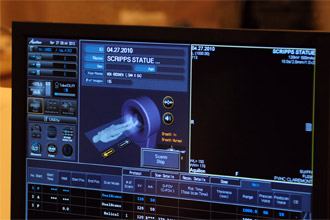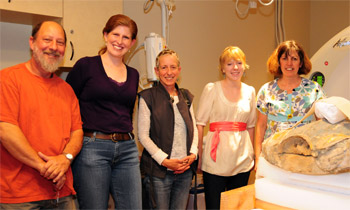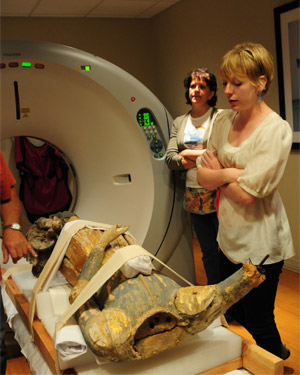Saint Michael needed a CAT scan.
A polychrome and gilded wooden sculpture, St. Michael (formally, Saint Michael Weighing Souls) hails from Perugia, Italy, circa 1450 CE. Owned by the Hecht family, the sculpture is currently stored at the Ruth Chandler Williamson Gallery at Scripps College. After decades of insect damage led to the need for conservation work, Scripps took this unique opportunity to train students in the college’s new Art Conservation major.
Art Conservation takes advantage of both the strong breadth of programs offered at Scripps College and its proximity to conservation laboratories at UCLA and the Getty Villa. Created by Professor Mary MacNaughton, the major is the only one of its kind at a college on the West Coast and prepares students for entry into conservation graduate programs at top institutions by requiring coursework in science, art history, art, and other fields. In addition, students can engage in internships at the Williamson Gallery or nearby institutions or enroll in off-campus courses of study to build their portfolio of practical experience.
Before his CAT scan, St. Michael had already been subject to a great deal of work by conservator Donna Williams and the Getty Villa Laboratories. Williams and art conservation major McKenzie Floyd ’12 painstakingly stabilized and consolidated the gesso (a type of primer), paint, and gilding of the statue. Questions remained, however, as to how to further treat the sculpture, particularly with regard to its assembly.
“What we really need is an X-ray,” remarked Williams.
Looking at the sculpture, wings removed, I recalled a CAT scan of the mummy Herakleides I had seen at the Getty Conservation Laboratories the previous month. “St. Michael is about the size of a human,” I answered. “Let’s see if we can get him to the doctor.”
 Walking into the Pomona Valley Medical Imaging Center, a new facility less than a quarter-mile from Scripps College, I approached the counter: “I have a 500 year-old patient by the name of St. Michael, a wooden sculpture in need of a CAT scan. He has a pre-existing condition and no medical insurance. Is there any way you would be willing to scan him for free?”
Walking into the Pomona Valley Medical Imaging Center, a new facility less than a quarter-mile from Scripps College, I approached the counter: “I have a 500 year-old patient by the name of St. Michael, a wooden sculpture in need of a CAT scan. He has a pre-existing condition and no medical insurance. Is there any way you would be willing to scan him for free?”
The receptionist didn’t bat an eyelash. “We scanned a dinosaur bone a few years back. Let’s talk with the director.” Dr. Johnson Lightfoote, Director of Imaging, generously approved an imaging session, and St. Michael officially had his first doctor’s appointment.
The appointment was set, but getting St. Michael to the doctor was not a trivial matter. Given the sculpture’s fragile state, it would need to be moved with extreme care. In preparation, Kirk Delman, Preparator of the Williamson Gallery, and T Robert, its Installer, set to building the sculpture a cushioned pallet sturdy enough for transport, but small enough so as not to exceed the 27-inch opening standard in CAT scan instruments. When the day arrived, St. Michael was carefully loaded onto a truck and transported to the facility; Nurses quickly ferried us through the back door into the instrument room, where we carefully set St. Michael onto the imaging table. Due to his outstretched arm, the sculpture was going to be a tight fit. The tension was palpable as the exam table slid towards the instrument… and successfully cleared the opening of the machine!
Gathering outside the room, we began to watch as the first images of St. Michael flashed across the screen. Points where the sculpture had been assembled were now visible, as well as the metal pins for assembly. Amazingly, St. Michael’s linden wood origins were also revealed: cross-sectional images clearly showed the tree rings from the trunk from which the sculpture had been carved.
 Images in hand, conservation work on St. Michael is now progressing. McKenzie is in the process of analyzing linen samples from St. Michael via electron microscopy at Pomona College; Scanning Electron Microscopy with X-ray microanalysis (SEM/EDS) is also being used to determine the elemental composition of the sculpture’s paint. Such scientific information will be used to restore St. Michael to a state as true to his origins as possible, with the stipulation that any treatment performed be reversible, a tenet of modern conservation practices.
Images in hand, conservation work on St. Michael is now progressing. McKenzie is in the process of analyzing linen samples from St. Michael via electron microscopy at Pomona College; Scanning Electron Microscopy with X-ray microanalysis (SEM/EDS) is also being used to determine the elemental composition of the sculpture’s paint. Such scientific information will be used to restore St. Michael to a state as true to his origins as possible, with the stipulation that any treatment performed be reversible, a tenet of modern conservation practices.
St. Michael’s prognosis is excellent.
Students interested in participating in the Art Conservation major can get more information here. Questions can also be directed to Professor Mary MacNaughton at the Ruth Chandler Williamson Gallery.
See Photos from the Scanning
Visit our Flickr photostream for photgraphs from St. Michael’s trip to the Pomona Valley Medical Imaging Center!


